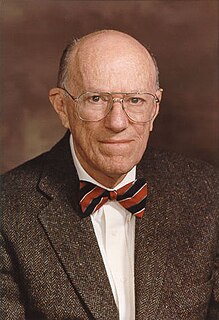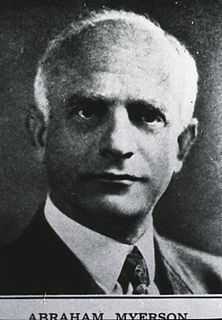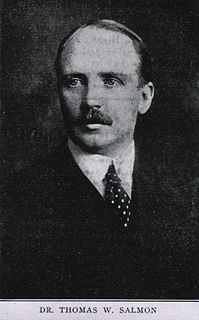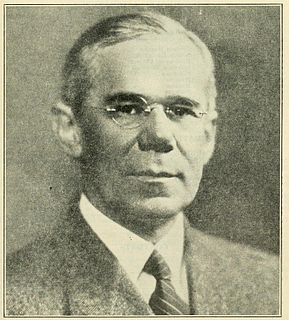This article needs additional citations for verification .(June 2021) |
Samuel Warren Hamilton, M.D. (1878-1951) was an American physician and psychiatrist who was an expert in the organization of mental hospitals.
This article needs additional citations for verification .(June 2021) |
Samuel Warren Hamilton, M.D. (1878-1951) was an American physician and psychiatrist who was an expert in the organization of mental hospitals.
Hamilton was born in Brandon, Vermont to Warren Henry Hamilton and Mary Salome Turrill, and was the fourth generation of physicians. He attended local public schools. He entered the University of Vermont and earned his A. B. degree in 1898. His medical education was at the Columbia University College of Physicians and Surgeons and earned his M.D. in 1903. He spent a year in training at the Children's Hospital of New York followed by a year at the Lying-in Hospital of the City of New York. [1]
From 1905 to 1909, he served as an assistant physician at the Manhattan State Mental Hospital, and then transferred to the Utica State Hospital (New York State Lunatic Asylum), where he served as a psychiatrist from 1910 to 1916. Between 1911 and 1912, he studied at the University of Breslau, Germany, and worked in the mental and nervous clinics.
In 1917, he became director of the New York Police's new Police Psychopathic Laboratory. However, with the start of World War I, Hamilton entered the U.S. Army. He spent two years as a psychiatrist with the 42nd Division and the Third Army. Upon his return from Europe, he became the Medical Director at the Philadelphia Hospital for Mental Disorder and served in this position from 1920 to 1922. Then, he took the position of Assistant Medical Director at the private hospital, Bloomingdale Insane Asylum which was affiliated with the Cornell Medical School and the New York Hospital. He remained at Bloomingdale from 1923 to 1936. During those years, he also served as director of Hospital Service for the National Committee for Mental Hygiene, a voluntary lay organization. This period began a career of surveys of public mental hospitals under the auspices of the National Committee for Mental Hygiene and later, the American Psychiatric Association, the American Neurological Association, the U.S. Public Health Service, and the Rockefeller Foundation.
Hamilton's experience in state mental hospitals came to the fore in the 1930s. The public mental hospitals in the various states had become overcrowded, understaffed, and received inadequate funding. Public interest had been aroused by publications of hospitals conditions. In 1935, the American Medical Association (AMA) began an investigation at the instigation of its Mental Health committee. The AMA surveys were discontinued and only a statistical report of the findings was published, with no known further action. Later, the American Psychiatric Association (APA) took up the effort and joined the national and state mental health associations in the effort to improve conditions in the mental hospitals. In 1928, the State Society for Mental Health of Connecticut obtained funds to conduct a survey of mental hospitals, under the direction of Hamilton. The survey was published in 1936 with numerous recommendations. The survey reports met wide acceptance as numerous states began obtaining funds for similar surveys, which often resulted in increased funding by state legislatures to improve conditions in the state mental hospitals.
Following his U.S. Army service during World War II, Hamilton accepted the position as Superintendent of the Essex Overbrook Hospital in New Jersey. He stayed there until 1950. He returned to Burlington, Vermont to continue his consultant activities. In 1951, the Governor of Vermont requested Hamilton's expertise with the Women's State Reformatory in Rutland, Vermont.
Hamilton taught during his various posts: the Canandaigua Academy in New York (1898-1899), the Allen School in New York (1900-1901), the Women's Medical College of New York (1920-1922), Associate Professor at the University of Pennsylvania and the Post Graduate School of Medicine (1920-1925).
He was a member of numerous professional organizations: the American Medical Association (AMA), the American Psychopathological Association (President in 1938), and the American Psychiatric Association (APA, president in 1946–1947). He served as an advisor to the U.S. Public Health Service from 1939 to 1947, and was an active participant in the founding of the American Board of Psychiatry and Neurology.
He died of a heart attack in 1951.
Hamilton, Samuel Warren. "Review of Infective-Exhaustive Psychoses with Special Reference to Subdivision and Prognosis," American Journal of Psychiatry 66(4) (April 1910): 579–586.
Hamilton, Samuel Warren, and Roy Haber. Summaries of State Laws Relating to the Feebleminded and the Epileptic. New York: National Committee for Mental Hygiene, 1917.
Hamilton, Samuel Warren. Report of the Rhode Island Mental Hygiene Survey, requested by Governor Emery J. San Souci and by the Penal and Charitable Commission. New York, 1924.
Hamilton, Samuel Warren. Report of the Connecticut Mental Hygiene Study. [New Haven, Quinnipiack Press, 1930].
Hamilton, Samuel Warren. "The Psychiatric Resources of New York: A Brief Description for those Attending the 1934 Meeting," American Journal of Psychiatry 90(5) (March 1934): 1097–1128.
Hamilton, Samuel Warren, and Grover A. Kempf. "Trends in the Activities of Mental Hospitals," American Journal of Psychiatry 96(3) (Nov. 1939): 551–574.
Hamilton, Samuel Warren, et al. A Study of the Public Mental Hospitals of the United States, 1937-39. Washington, DC: U.S. Government Printing Office, 1941.
Stern, Edith M., and Samuel Warren Hamilton. The Mental Hospital: A Guide for the Citizen. New York: The Commonwealth Fund, 1942.
Hamilton, Samuel Warren. "The History of Mental Hospitals" in One Hundred Years of American Psychiatry. New York: Publication for the American Psychiatric Association by Columbia University Press, 1944.
Stern, Edith M., and Samuel Warren Hamilton. Better Mental Hospitals: A Guide for the Citizen. New York: National Committee for Mental Hygiene, 1947.

Leon Eisenberg, was an American child psychiatrist, social psychiatrist and medical educator who "transformed child psychiatry by advocating research into developmental problems"
The Association of Medical Superintendents of American Institutions for the Insane, also known as The Superintendents' Association, was organized in Philadelphia in October, 1844 at a meeting of 13 superintendents, making it the first professional medical specialty organization in the U.S.
Geriatric psychiatry, also known as geropsychiatry, psychogeriatrics or psychiatry of old age, is a branch of medicine and a subspecialty of psychiatry dealing with the study, prevention, and treatment of neurodegenerative, cognitive impairment, and mental disorders in people of old age. Geriatric psychiatry as a subspecialty has significant overlap with the specialties of geriatric medicine, behavioural neurology, neuropsychiatry, neurology, and general psychiatry. Geriatric psychiatry has become an official subspecialty of psychiatry with a defined curriculum of study and core competencies.
Psychiatry is the medical specialty devoted to the diagnosis, prevention, and treatment of mental disorders. These include various maladaptations related to mood, behaviour, cognition, and perceptions. See glossary of psychiatry.
Charles Macfie Campbell (1876–1943) was a psychiatrist in the United States. He was President of the American Psychiatric Association.

The Goldwater rule is Section 7 in the American Psychiatric Association's (APA) Principles of Medical Ethics, which states that psychiatrists have a responsibility to participate in activities contributing to the improvement of the community and the betterment of public health, but they should not give a professional opinion about public figures whom they have not examined in person, and from whom they have not obtained consent to discuss their mental health in public statements. It is named after former US Senator and 1964 presidential nominee Barry Goldwater.
The following outline is provided as an overview of and topical guide to psychiatry:
Winfred Overholser was an American psychiatrist, president of the American Psychiatric Association, and for 25 years the superintendent of St. Elizabeths Hospital, a federal institution for the mentally ill in Washington, D.C.
Marion Edwena Kenworthy, M.D. (1891-1980), an American psychiatrist and psychoanalyst, introduced psychiatric and psychoanalytic concepts to the education of social workers and to the field of social work.

August Hoch was a Swiss–American psychiatrist who was the third director of the New York State Psychiatric Institute in New York City from 1 February 1910 to 1 October 1917. As a neuropathologist and clinician, he exerted his influence on psychiatric developments during the early 20th century in the United States.

Abraham Myerson (1881–1948) was a Lithuanian neurologist, psychiatrist, clinician, pathologist, and researcher. He had a special interest in the heredity of psychiatric and neurologic disease.
Harry C. Solomon (1889–1982), an American neurologist, psychiatrist, researcher, administrator, and clinician, was among the first to advocate for major changes in public psychiatry. He called for the closure of large, public mental hospitals and replaced with community-based facilities.
Daniel Blain, M.D. (1898–1981) was an American physician and was the first medical director of the American Psychiatric Association (APA), the first professional medical society, founded in the United States in 1844. He may be credited with the leadership which brought changes in the practice of psychiatry after World War II and in advocating the treatment for people with mental disorders.
James Vance May (1873–1947) was an American psychiatrist and an early proponent for statistical studies and classification of mental diseases. He was among the first to recognize mental disease as a public health problem, a view that did not gain recognition and acceptance for many years.

Thomas William Salmon, M.D. (1876-1927) was a leader of the mental hygiene movement in the United States in early twentieth century.

George Hughes Kirby (1875–1935) was an American physician and psychiatrist, administrator, and educator, who contributed to the advancement of psychiatry in the United States.
Henry Alexander Davidson was an American physician, a psychiatric administrator, and a proponent of forensic psychiatry.
Walter Earl Barton, M.D. (1906–1999) was an American physician, a psychiatric administrator, and a leader in American psychiatry.
Harvey John Tompkins, M.D. (1906–1983) was an American physician, a psychiatrist, whose professional life was in public service.
Mark S. Komrad is an American psychiatrist on the clinical and teaching staff of the Johns Hopkins Hospital in Baltimore. He is the author of You Need Help: A Step-by-Step Plan to Convince Your Loved One to Get Counseling.